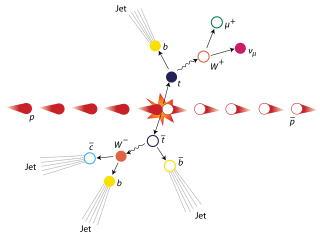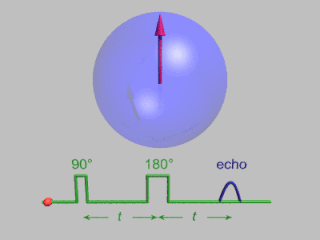Related Research Articles

The muon is an elementary particle similar to the electron, with an electric charge of −1 e and a spin of 1/2, but with a much greater mass. It is classified as a lepton. As with other leptons, the muon is not known to have any sub-structure – that is, it is not thought to be composed of any simpler particles.

Antihydrogen is the antimatter counterpart of hydrogen. Whereas the common hydrogen atom is composed of an electron and proton, the antihydrogen atom is made up of a positron and antiproton. Scientists hope that studying antihydrogen may shed light on the question of why there is more matter than antimatter in the observable universe, known as the baryon asymmetry problem. Antihydrogen is produced artificially in particle accelerators.
The strange quark or s quark is the third lightest of all quarks, a type of elementary particle. Strange quarks are found in subatomic particles called hadrons. Examples of hadrons containing strange quarks include kaons, strange D mesons, Sigma baryons, and other strange particles.

The omega baryons are a family of subatomic hadron particles that are represented by the symbol
Ω
and are either neutral or have a +2, +1 or −1 elementary charge. They are baryons containing no up or down quarks. Omega baryons containing top quarks are not expected to be observed. This is because the Standard Model predicts the mean lifetime of top quarks to be roughly 5×10−25 s, which is about a twentieth of the timescale for strong interactions, and therefore that they do not form hadrons.

The top quark, sometimes also referred to as the truth quark, is the most massive of all observed elementary particles. It derives its mass from its coupling to the Higgs Boson. This coupling is very close to unity; in the Standard Model of particle physics, it is the largest (strongest) coupling at the scale of the weak interactions and above. The top quark was discovered in 1995 by the CDF and DØ experiments at Fermilab.
A hypernucleus is a nucleus which contains at least one hyperon in addition to the normal protons and neutrons. The first was discovered by Marian Danysz and Jerzy Pniewski in 1952 using the nuclear emulsion technique, based on their energetic but delayed decay. They have also been studied by measuring the momenta of the K and pi mesons in the direct strangeness exchange reactions.
Microwave spectroscopy is the spectroscopy method that employs microwaves, i.e. electromagnetic radiation at GHz frequencies, for the study of matter.
There are 39 known isotopes and 17 nuclear isomers of tellurium (52Te), with atomic masses that range from 104 to 142. These are listed in the table below.
Potassium (19K) has 26 known isotopes from 31K to 57K, with the exception of still-unknown 32K, as well as an unconfirmed report of 59K. Three of those isotopes occur naturally: the two stable forms 39K (93.3%) and 41K (6.7%), and a very long-lived radioisotope 40K (0.012%)
Rutherfordium (104Rf) is a synthetic element and thus has no stable isotopes. A standard atomic weight cannot be given. The first isotope to be synthesized was either 259Rf in 1966 or 257Rf in 1969. There are 16 known radioisotopes from 253Rf to 270Rf and 4 isomers. The longest-lived isotope is 267Rf with a half-life of 2.5 hours, and the longest-lived isomer is 261mRf with a half-life of 81 seconds.
In spectroscopy, a forbidden mechanism is a spectral line associated with absorption or emission of photons by atomic nuclei, atoms, or molecules which undergo a transition that is not allowed by a particular selection rule but is allowed if the approximation associated with that rule is not made. For example, in a situation where, according to usual approximations, the process cannot happen, but at a higher level of approximation the process is allowed but at a low rate.

In magnetic resonance, a spin echo is the refocusing of spin magnetisation by a pulse of resonant electromagnetic radiation. Modern nuclear magnetic resonance (NMR) and magnetic resonance imaging (MRI) make use of this effect.
Quantum electrodynamics (QED), a relativistic quantum field theory of electrodynamics, is among the most stringently tested theories in physics. The most precise and specific tests of QED consist of measurements of the electromagnetic fine-structure constant, α, in various physical systems. Checking the consistency of such measurements tests the theory.
Spin engineering describes the control and manipulation of quantum spin systems to develop devices and materials. This includes the use of the spin degrees of freedom as a probe for spin based phenomena. Because of the basic importance of quantum spin for physical and chemical processes, spin engineering is relevant for a wide range of scientific and technological applications. Current examples range from Bose–Einstein condensation to spin-based data storage and reading in state-of-the-art hard disk drives, as well as from powerful analytical tools like nuclear magnetic resonance spectroscopy and electron paramagnetic resonance spectroscopy to the development of magnetic molecules as qubits and magnetic nanoparticles. In addition, spin engineering exploits the functionality of spin to design materials with novel properties as well as to provide a better understanding and advanced applications of conventional material systems. Many chemical reactions are devised to create bulk materials or single molecules with well defined spin properties, such as a single-molecule magnet. The aim of this article is to provide an outline of fields of research and development where the focus is on the properties and applications of quantum spin.

Hughes–Drever experiments are spectroscopic tests of the isotropy of mass and space. Although originally conceived of as a test of Mach's principle, it is now understood to be an important test of Lorentz invariance. As in Michelson–Morley experiments, the existence of a preferred frame of reference or other deviations from Lorentz invariance can be tested, which also affects the validity of the equivalence principle. Thus these experiments concern fundamental aspects of both special and general relativity. Unlike Michelson–Morley type experiments, Hughes–Drever experiments test the isotropy of the interactions of matter itself, that is, of protons, neutrons, and electrons. The accuracy achieved makes this kind of experiment one of the most accurate confirmations of relativity .

Modern searches for Lorentz violation are scientific studies that look for deviations from Lorentz invariance or symmetry, a set of fundamental frameworks that underpin modern science and fundamental physics in particular. These studies try to determine whether violations or exceptions might exist for well-known physical laws such as special relativity and CPT symmetry, as predicted by some variations of quantum gravity, string theory, and some alternatives to general relativity.

The Research Institute for Nuclear Problems of Belarusian State University is a research institute in Minsk, Belarus. Its main fields of research are nuclear physics and particle physics.

Kam-Biu Luk is a professor of physics, with a focus on particle physics, at UC Berkeley and a senior faculty scientist in the Lawrence Berkeley National Laboratory's physics division. Luk has conducted research on neutrino oscillation and CP violation. Luk and his collaborator Yifang Wang were awarded the 2014 Panofsky Prize “for their leadership of the Daya Bay experiment, which produced the first definitive measurement of θ13 angle of the neutrino mixing matrix.” His work on neutrino oscillation also received 2016 Breakthrough Prize in Fundamental Physics shared with other teams. He also received a Doctor of Science honoris causa from the Hong Kong University of Science and Technology in 2016. Luk is a fellow of the American Physical Society, and the American Academy of Arts and Sciences.

Luigi Di Lella is an Italian experimental particle physicist. He has been a staff member at CERN for over 40 years, and has played an important role in major experiments at CERN such as CAST and UA2. From 1986 to 1990 he acted as spokesperson for the UA2 Collaboration, which, together with the UA1 Collaboration, discovered the W and Z bosons in 1983.

Pierre Darriulat is a French experimental particle physicist. As staff member at CERN, he contributed in several prestigious experiments. He was the spokesperson of the UA2 collaboration from 1981 to 1986, during which time the UA2 collaboration, together with the UA1 collaboration, discovered the W and Z bosons in 1983.